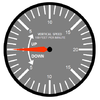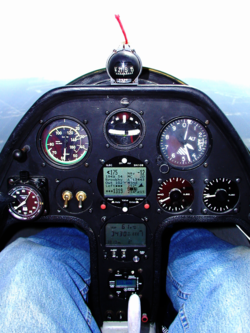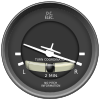There are basic flight instruments such as the altimeter that displays aircraft altitude; the airspeed indicator; and the magnetic direction indicator, a form of compass. Additionally, an artificial horizon, turn coordinator, and vertical speed indicator are flight instruments present in most aircraft.
Flight instruments are the instruments in the cockpit of an aircraft that provide the pilot with information about the flight situation of that aircraft, such as altitude, airspeed and direction. They improve safety by allowing the pilot to fly the aircraft in level flight, and make turns, without a reference outside the aircraft such as the horizon. Visual flight rules (VFR) require an airspeed indicator, an altimeter, and a compass or other suitable magnetic direction indicator. Instrument flight rules (IFR) additionally require a gyroscopic pitch-bank (artificial horizon), direction (directional gyro) and rate of turn indicator, plus a slip-skid indicator, adjustable altimeter, and a clock. Flight into Instrument meteorological conditions (IMC) require radio navigation instruments for precise takeoffs and landings.
The term is sometimes used loosely as a synonym for cockpit instruments as a whole, in which context it can include engine instruments, navigational and communication equipment. Many modern aircraft have electronic flight instrument systems.
Pitot-static systems
Altimeter
-
The altimeter shows the aircraft's altitude above sea-level by measuring the difference between the pressure in a stack of aneroid capsules inside the altimeter and the atmospheric pressure obtained through the static system. It is adjustable for local barometric pressure which must be set correctly to obtain accurate altitude readings. As the aircraft ascends, the capsules expand and the static pressure drops, causing the altimeter to indicate a higher altitude. The opposite effect occurs when descending. With the advancement in aviation and increased altitude ceiling, the altimeter dial had to be altered for use both at higher and lower altitudes. Hence when the needles were indicating lower altitudes i.e. the first 360-degree operation of the pointers was delineated by the appearance of a small window with oblique lines warning the pilot that he or she is nearer to the ground. This modification was introduced in the early sixties after the recurrence of air accidents caused by the confusion in the pilot's mind. At higher altitudes, the window will disappear.
Airspeed indicator
-
The airspeed indicator shows the aircraft's speed (usually in knots ) relative to the surrounding air. It works by measuring the ram-air pressure in the aircraft's Pitot tube relative to the ambient static pressure. The indicated airspeed (IAS) must be corrected for nonstandard pressure and temperature in order to obtain the true airspeed (TAS). The instrument is color coded to indicate important airspeed such as the stall speed, never-exceed airspeed, or safe flap operation speeds.
Vertical speed indicator
-
The VSI (also sometimes called a variometer, or rate of climb indicator) senses changing air pressure, and displays that information to the pilot as a rate of climb or descent in feet per minute, meters per second or knots.
Compass Systems
-
The compass shows the aircraft's heading relative to magnetic north. Errors include Variation, or the difference between magnetic and true direction, and Deviation, caused by the electrical wiring in the aircraft, which requires a Compass Correction Card. Additionally, the compass is subject to Dip Errors. While reliable in steady level flight it can give confusing indications when turning, climbing, descending, or accelerating due to the inclination of the Earth's magnetic field. For this reason, the heading indicator is also used for aircraft operation, but periodically calibrated against the compass.
Gyroscopic Systems
-
The attitude indicator (also known as an artificial horizon) shows the aircraft's relation to the horizon. From this the pilot can tell whether the wings are level (roll) and if the aircraft nose is pointing above or below the horizon (pitch). This is a primary instrument for instrument flight and is also useful in conditions of poor visibility. Pilots are trained to use other instruments in combination should this instrument or its power fail.
Heading Indicator
-
The heading indicator (also known as the directional gyro, or DG) displays the aircraft's heading with respect to magnetic north when set with a compass. Bearing friction causes drift errors from precession, which must be periodically corrected by calibrating the instrument to the magnetic compass.In many advanced aircraft (including almost all jet aircraft), the heading indicator is replaced by a horizontal situation indicator (HSI) which provides the same heading information, but also assists with navigation.
Turn Indicator
-
These include the Turn-and-Slip Indicator and the Turn Coordinator, which indicate rotation about the longitudinal axis. They include an inclinometer to indicate if the aircraft is in Coordinated flight, or in a Slip or Skid. Additional marks indicate a Standard rate turn.
Flight Director Systems
These include the Horizontal Situation Indicator (HSI) and Attitude Director Indicator (ADI). The HSI combines the magnetic compass with navigation signals and a Glide slope. The navigation information comes from a VOR/Localizer, or GPS. The ADI is an Attitude Indicator with computer-driven steering bars, a task reliever during instrument flight
Navigational Systems
-
The VOR indicator instrument includes a Course deviation indicator (CDI), Omnibearing Selector (OBS), TO/FROM indicator, and Flags. The CDI shows an aircraft's lateral position in relation to a selected radial track. It is used for orientation, tracking to or from a station, and course interception
Nondirectional Radio Beacon (NDB)
-
The Automatic direction finder (ADF) indicator instrument can be a fixed-card, movable card, or a Radio magnetic indicator (RMI). An RMI is remotely coupled to a gyrocompass so that it automatically rotates the azimuth card to represent aircraft heading.While simple ADF displays may have only one needle, a typical RMI has two, coupled to different ADF receivers, allowing for position fixing using one instrument.
These are the Basic Six Instruments.
- Get link
- X
- Other Apps
- Get link
- X
- Other Apps












Comments
Post a Comment